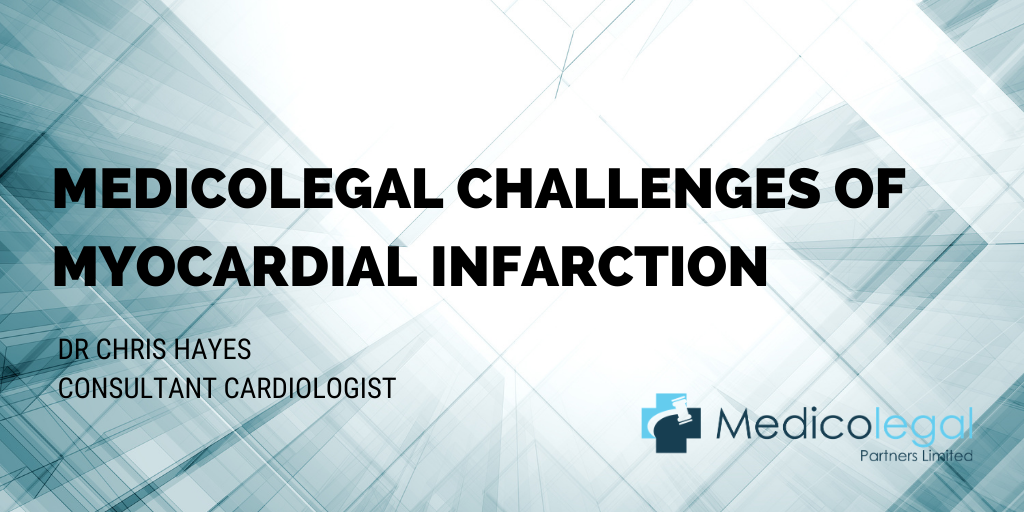The Medicolegal Challenges of Myocardial Infarction

A myocardial infarction (MI), also known as a heart attack, occurs when the blood supply to part of the heart is reduced or stops completely. This causes damage to the myocardium, or heart muscle, and results in tissue necrosis.
The most common reason for MI is coronary heart disease (CHD). In the UK, over 100,000 people are admitted to hospital each year following MI. Although the chances of surviving MI have increased markedly in the last 50 years, around 30% of sufferers will die as a result of the event, and it is the cause of one in every four deaths each year in the UK. Therefore, prompt treatment is vital to ensure the patient’s best chance of survival.
Allegations of failure to identify and correctly treat MI make up the largest proportion of cases of negligence brought against cardiologists, and it has been estimated that up to 25% of cardiac events go unrecognised. The most common reasons for a missed MI include a failure to suspect the condition in the first place; failing to order, or delay in ordering, appropriate investigations; no or late hospital admission; and misinterpretation of test results, including electrocardiograms (ECGs). Even if the actual MI may have arisen as part of the natural progression of CHD, and is not the fault of the cardiologist, a failure to recognise and treat the condition represents a lost opportunity to modify, and possibly improve, the outcome for the patient. This is known as a ‘loss of chance’, whereby a negative outcome, which is preventable in a definable percentage of cases, could have been prevented if the condition had been promptly recognised and treated appropriately.
The most common symptom of MI is chest pain, which may also travel into the shoulder, arm, back, neck or jaw. ECGs and blood tests for the levels of cardiac enzymes may also be used to aid diagnosis. However, up to 30% of patients present with atypical symptoms, such as abdominal pain, shortness of breath and congestive heart failure, and the likelihood of a correct diagnosis being made can be influenced by both the patient’s and the doctor’s beliefs about MI risk. For example, around 5% of MIs occur in patients below 40 years of age, a group often believed to be ‘too young’ to have a heart attack, so a doctor may not even consider this as a potential diagnosis. Women, particularly those from ethnic minorities, are also more likely to be the subject of a missed diagnosis.
Additionally, a number of other conditions, such as gastrointestinal problems, musculoskeletal pain and even anxiety, may present with symptoms that mirror those of MI, and there are over 250 noncardiac conditions that can result in chest pain. While some patients will present with a medical history that clearly indicates the possibility of MI, it can also occur in subjects with no clinical risk factors at all. Furthermore, the changes seen on ECGs and blood tests that would indicate MI may not be present until several hours after the event. Thus, making an accurate diagnosis of MI is not always straightforward, and clinicians often face the dilemma of subjecting a patient to further testing or hospitalisation in order to rule out MI, or discharging the patient and risking the condition being missed. In view of these issues, a cardiologist is unlikely to be considered liable for failing to diagnose MI in patients who do not initially present with chest pain, or where the chest pain present is clearly atypical. A lack of symptoms, or significant risk factors, typical of CHD, or an alternative diagnosis which sufficiently explains the observed symptoms, would also reduce the likelihood of a successful claim being made.
Although the majority of medicolegal challenges associated with MI surround a failure to diagnose the condition, issues can also arise during treatment. Tissue plasminogen activator, coronary artery bypass graft and percutaneous coronary intervention are all used to treat MI. However, all of them are associated with a relatively high risk of adverse events, such as intracranial haemorrhage, allergic reactions, vascular damage, stroke and hypotension, which may then lead to litigation, particularly if the expectations of patients in terms of outcome are excessively optimistic. The informed consent process, in which the possible risks of any treatment are made clear to the patient, will be a vital part of claim prevention.
A missed MI is one of the most common reasons for a ‘failure to diagnose’ claim to be launched. This is partly due to the fact that this is a high-risk area of practice which carries a correspondingly elevated risk of liability for alleged negligence. These claims are also associated with large average payments, reflecting the high burden of disease associated with a heart attack and the impact on the patient’s life. MI is difficult to diagnose, as many patients do not present with classic symptoms. Therefore, in order to avoid subsequent claims, doctors need to maintain a high index of suspicion for MI, particularly in patients with a known history of cardiac risk factors. A wise approach may be to assume that all sudden chest pain is cardiac in origin until proven otherwise.
Further reading:
Abbott R, Cohen M. Medico-legal issues in cardiology. Cardiology in Review. 2013; 21(5): 222-228.
Bird S. Acute myocardial infarction: medicolegal issues. Australian Family Physician. 2005; 34(6): 489-490.
